![]() September
September
This month's features in our early
autumn issue :
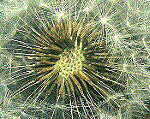
At this time of year as autumn approaches many flowers are setting seed. So this month why not examine in close-up the wonderful colours, shapes and textures of plant seeds and seed heads in your garden or local countryside. Only a low power stereo microscope or 10X hand lens is required. At higher magnifications why not also take a look at the intricate detail of butterfly wing scales.
Please read the important notes on collecting.
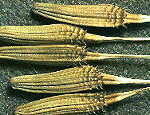 Although there are
still many plants in flower in the author's area, most are now
setting seed or developing fruits. So this is an excellent time
of year to admire the wonderful variety of forms of seeds, and
how they often relate to their method of dispersal.
Although there are
still many plants in flower in the author's area, most are now
setting seed or developing fruits. So this is an excellent time
of year to admire the wonderful variety of forms of seeds, and
how they often relate to their method of dispersal.
Dock
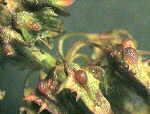 The docks (genus Rumex)
are a common flower in the UK but are often overlooked by the
casual observer because of their undistinguished greenish flowers
which are typically on whorls in a flower-spike. The flower
structure and seed heads are unusual and worth studying in
close-up ( a guide to wild flowers should give a general
impression of the type of plant to look out for).
The docks (genus Rumex)
are a common flower in the UK but are often overlooked by the
casual observer because of their undistinguished greenish flowers
which are typically on whorls in a flower-spike. The flower
structure and seed heads are unusual and worth studying in
close-up ( a guide to wild flowers should give a general
impression of the type of plant to look out for).
Clover
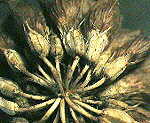 The clover, genus (Trifolium),
needs no introduction as it is common as the red or white clover
in grassland. Clovers are members of the pea family Leguminosae
and the tiny pea-flowers form the familiar attractive globular
clusters of flowers. They are also attractive when they turn to
seed because the flower heads turn a rusty-brown colour, and a
typical example is shown in the image left.
The clover, genus (Trifolium),
needs no introduction as it is common as the red or white clover
in grassland. Clovers are members of the pea family Leguminosae
and the tiny pea-flowers form the familiar attractive globular
clusters of flowers. They are also attractive when they turn to
seed because the flower heads turn a rusty-brown colour, and a
typical example is shown in the image left.
Bramble
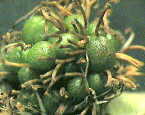 One of the benefits of a nature
walk in Autumn is eating the edible fruits that are beginning to
ripen! A common one in the author's area is the bramble (genus Rubus)
which after forming white or pink flowers develops the familiar
blackberries. It is interesting to see how the fruits slowly
develop from the flower. A fruit in an early stage of development
is shown on the right. The fruit is still green and the remains
of the anthers from the flower can be seen.
One of the benefits of a nature
walk in Autumn is eating the edible fruits that are beginning to
ripen! A common one in the author's area is the bramble (genus Rubus)
which after forming white or pink flowers develops the familiar
blackberries. It is interesting to see how the fruits slowly
develop from the flower. A fruit in an early stage of development
is shown on the right. The fruit is still green and the remains
of the anthers from the flower can be seen.
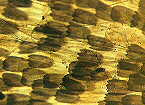 At this
time of year as the butterflies are finishing their breeding and
egg-laying, butterflies are often found dead on the ground during
a walk. It is well worth carefully collecting a few of the intact
butterflies and taking home in a container for closer
observation. Examining the wings under a stereo microscope or
compound microscope at about 40X will show the arrangement of the
wing scales. The scales overlap in rows similar to tiles on a
roof and are actually modified hairs. In some of the more
primitive members of the Lepidoptera (= scale wings) the scales
are distinctly hair-like. The scales shown left are those forming
the black markings on the wings of the large white butterfly (Pieris
brassicae). The visible size of each overlapping scale shown
is typically 105um long and 50um wide (um=micron, 1/1000th of a
milllimetre). If you examine a dislodged scale you should see the
peg at one end which fits into a pore in the wing membrane.
At this
time of year as the butterflies are finishing their breeding and
egg-laying, butterflies are often found dead on the ground during
a walk. It is well worth carefully collecting a few of the intact
butterflies and taking home in a container for closer
observation. Examining the wings under a stereo microscope or
compound microscope at about 40X will show the arrangement of the
wing scales. The scales overlap in rows similar to tiles on a
roof and are actually modified hairs. In some of the more
primitive members of the Lepidoptera (= scale wings) the scales
are distinctly hair-like. The scales shown left are those forming
the black markings on the wings of the large white butterfly (Pieris
brassicae). The visible size of each overlapping scale shown
is typically 105um long and 50um wide (um=micron, 1/1000th of a
milllimetre). If you examine a dislodged scale you should see the
peg at one end which fits into a pore in the wing membrane.
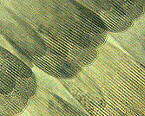 The
scales and hairs on the butterfly wing are responsible for the
colours and patterns. Some of the colour is caused by
pigmentation created by chemically diverse compounds such as
melanins and flavones. Blue and green is a rare pigment in
butterflies and moths although a common colour of the wings.
These colours are typically created by the microstructure of the
hairs and scales which refract light to produce these colours as
well as the metallic and iridescent effects.
The
scales and hairs on the butterfly wing are responsible for the
colours and patterns. Some of the colour is caused by
pigmentation created by chemically diverse compounds such as
melanins and flavones. Blue and green is a rare pigment in
butterflies and moths although a common colour of the wings.
These colours are typically created by the microstructure of the
hairs and scales which refract light to produce these colours as
well as the metallic and iridescent effects.
Fruits and seeds
There are many wild-flower books available for the naturalist
many of which should show the diversity of seeds and fruits of
flowering plants. For the botanist, the fruits and seeds of
plants are often used as a critical diagnostic character to help
identify the plant.
Butterfly wing scales
An excellent introduction to the structure of butterfly wing
scales which is illustrated with SEM photographs is:
'The Wings of the Peacock Butterfly' by M O Moss
and G Gibbs, Quekett J. of Microscopy, 1995, 37(5),
392-395.
The seed and fruit images were taken using a CCD camera with a
50mm SLR camera lens and extension tubes attached. The butterfly
scale images were taken with the CCD camera attached to a Russian
Biolam compound microscope with no eyepiece using a 3.5X and 20X
objective.
Camera images were transferred to the PC using a Creative Video
Spigot capture card.
Image manipulation using Photostyler v2.0 software.
The author Dave Walker
is a UK based amateur naturalist keen to encourage people to
explore nature in close-up.